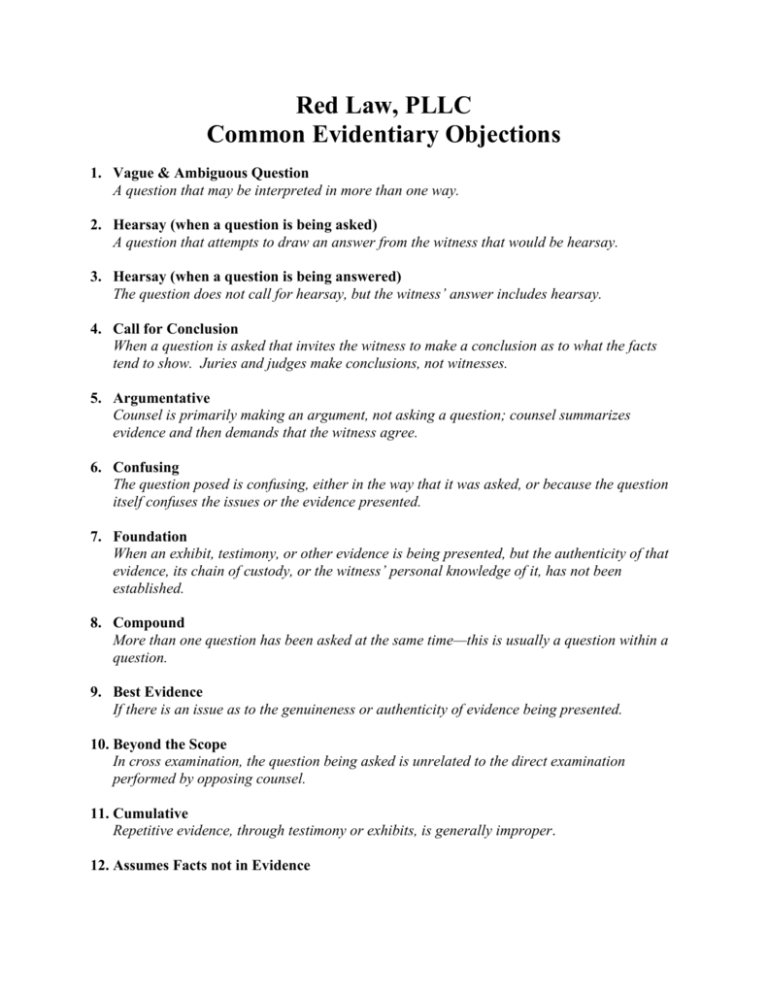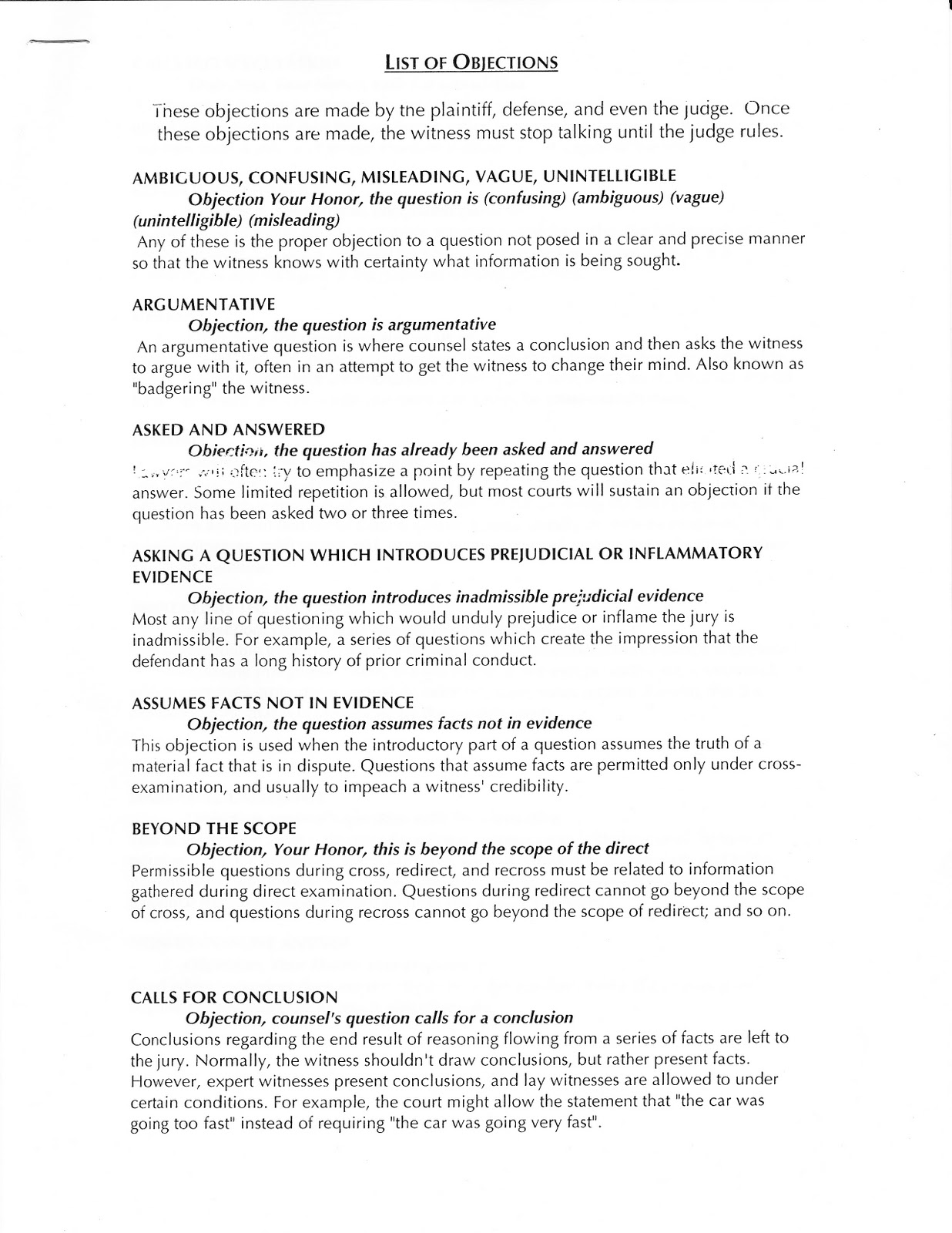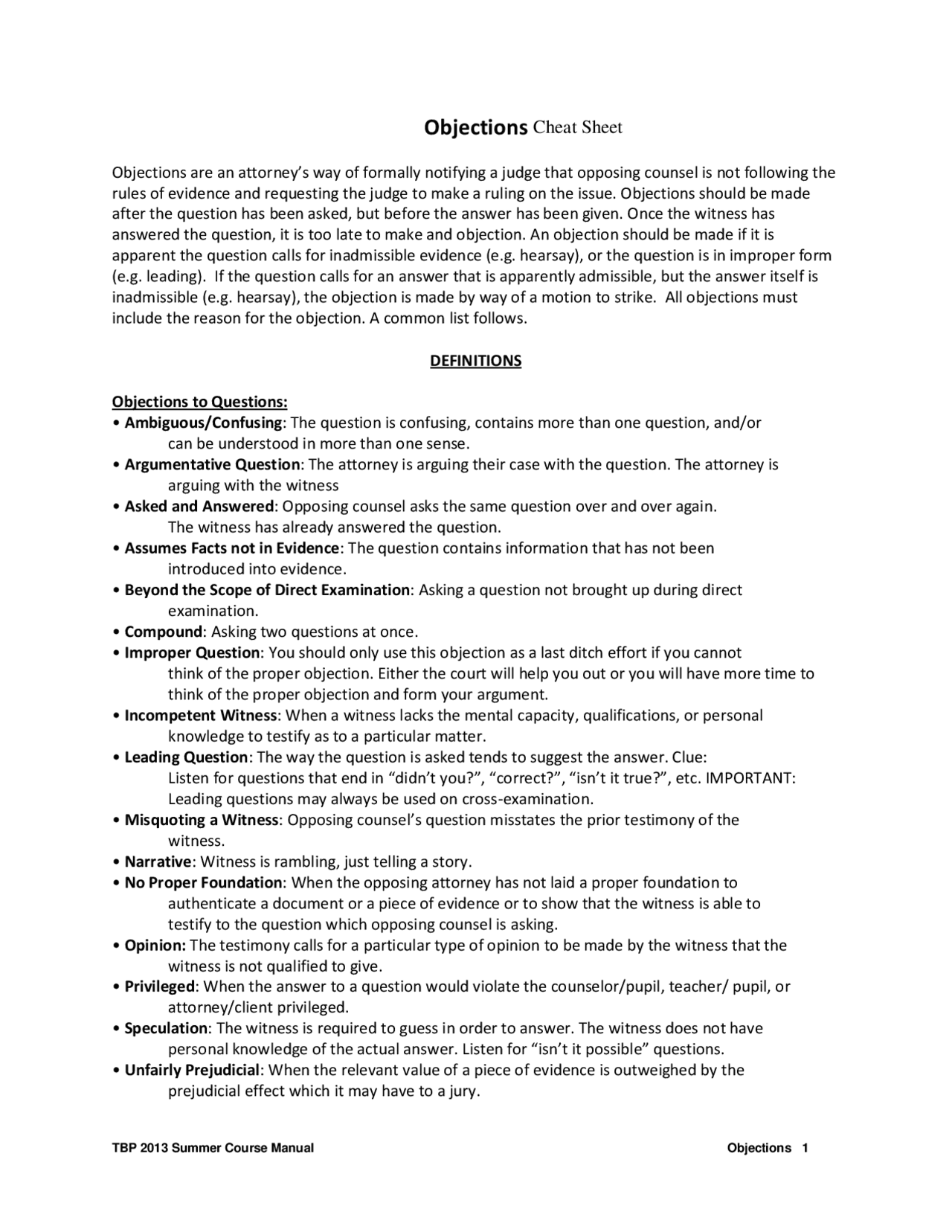Common Trial Objections Cheat Sheet
Common Trial Objections Cheat Sheet - What are the two ways a judge can rule on an objection? With this cheat sheet, you can quickly object to an. This section will better explain the purpose behind the objection. Repeats the same question 7. Questions may be objectionable because they violate one of the “big four” evidentiary principles (relevance, authentication, hearsay, privilege) or. This checklist sets out the grounds and rationale for the most common objections, as well as responses and exceptions to those objections. Contains as a predicate a statement. What are the most common objections in court? This section will be an example of how you can make your objection to the court. A ssuming facts not in evidence:
With this cheat sheet, you can quickly object to an. This checklist sets out the grounds and rationale for the most common objections, as well as responses and exceptions to those objections. A ssuming facts not in evidence: This section will better explain the purpose behind the objection. This section will be an example of how you can make your objection to the court. What are the two ways a judge can rule on an objection? What are the most common objections in court? This table sets out the most common objections, as well as exceptions to those objections. Contains as a predicate a statement. Repeats the same question 7.
A ssuming facts not in evidence: What are the two ways a judge can rule on an objection? Contains as a predicate a statement. With this cheat sheet, you can quickly object to an. This section will be an example of how you can make your objection to the court. What are the most common objections in court? This table sets out the most common objections, as well as exceptions to those objections. Questions may be objectionable because they violate one of the “big four” evidentiary principles (relevance, authentication, hearsay, privilege) or. This section will better explain the purpose behind the objection. This checklist sets out the grounds and rationale for the most common objections, as well as responses and exceptions to those objections.
Common Trial Objections Hearsay Witness
What are the two ways a judge can rule on an objection? This section will be an example of how you can make your objection to the court. Questions may be objectionable because they violate one of the “big four” evidentiary principles (relevance, authentication, hearsay, privilege) or. This checklist sets out the grounds and rationale for the most common objections,.
Objections Cheat Sheet A Comprehensive Guide to Common Objections and
What are the two ways a judge can rule on an objection? Repeats the same question 7. What are the most common objections in court? This checklist sets out the grounds and rationale for the most common objections, as well as responses and exceptions to those objections. This table sets out the most common objections, as well as exceptions to.
a list of common objections to evidence
Repeats the same question 7. This checklist sets out the grounds and rationale for the most common objections, as well as responses and exceptions to those objections. Questions may be objectionable because they violate one of the “big four” evidentiary principles (relevance, authentication, hearsay, privilege) or. What are the two ways a judge can rule on an objection? Contains as.
Common Trial Objections Evidence (Law) Witness
This section will better explain the purpose behind the objection. This section will be an example of how you can make your objection to the court. With this cheat sheet, you can quickly object to an. This checklist sets out the grounds and rationale for the most common objections, as well as responses and exceptions to those objections. Repeats the.
Court Objections Cheat Sheet Printable Templates Free
A ssuming facts not in evidence: What are the most common objections in court? This section will be an example of how you can make your objection to the court. This checklist sets out the grounds and rationale for the most common objections, as well as responses and exceptions to those objections. Repeats the same question 7.
A Comprehensive Guide to Common Objections, Privileges, Motions and
This section will be an example of how you can make your objection to the court. Questions may be objectionable because they violate one of the “big four” evidentiary principles (relevance, authentication, hearsay, privilege) or. Contains as a predicate a statement. What are the most common objections in court? Repeats the same question 7.
Objections Cheat Sheet PDF
Questions may be objectionable because they violate one of the “big four” evidentiary principles (relevance, authentication, hearsay, privilege) or. What are the most common objections in court? This checklist sets out the grounds and rationale for the most common objections, as well as responses and exceptions to those objections. This table sets out the most common objections, as well as.
Common Objections In Court Cheat Sheet prntbl.concejomunicipaldechinu
A ssuming facts not in evidence: What are the most common objections in court? Contains as a predicate a statement. This table sets out the most common objections, as well as exceptions to those objections. This section will be an example of how you can make your objection to the court.
Common Objections In Court Cheat Sheet prntbl.concejomunicipaldechinu
This checklist sets out the grounds and rationale for the most common objections, as well as responses and exceptions to those objections. What are the most common objections in court? What are the two ways a judge can rule on an objection? Repeats the same question 7. Contains as a predicate a statement.
2013 Objections Trial Techniques Deposition (Law) Cross Examination
A ssuming facts not in evidence: This section will be an example of how you can make your objection to the court. With this cheat sheet, you can quickly object to an. This section will better explain the purpose behind the objection. This checklist sets out the grounds and rationale for the most common objections, as well as responses and.
A Ssuming Facts Not In Evidence:
This section will better explain the purpose behind the objection. This table sets out the most common objections, as well as exceptions to those objections. Questions may be objectionable because they violate one of the “big four” evidentiary principles (relevance, authentication, hearsay, privilege) or. What are the most common objections in court?
Contains As A Predicate A Statement.
What are the two ways a judge can rule on an objection? Repeats the same question 7. This checklist sets out the grounds and rationale for the most common objections, as well as responses and exceptions to those objections. This section will be an example of how you can make your objection to the court.









